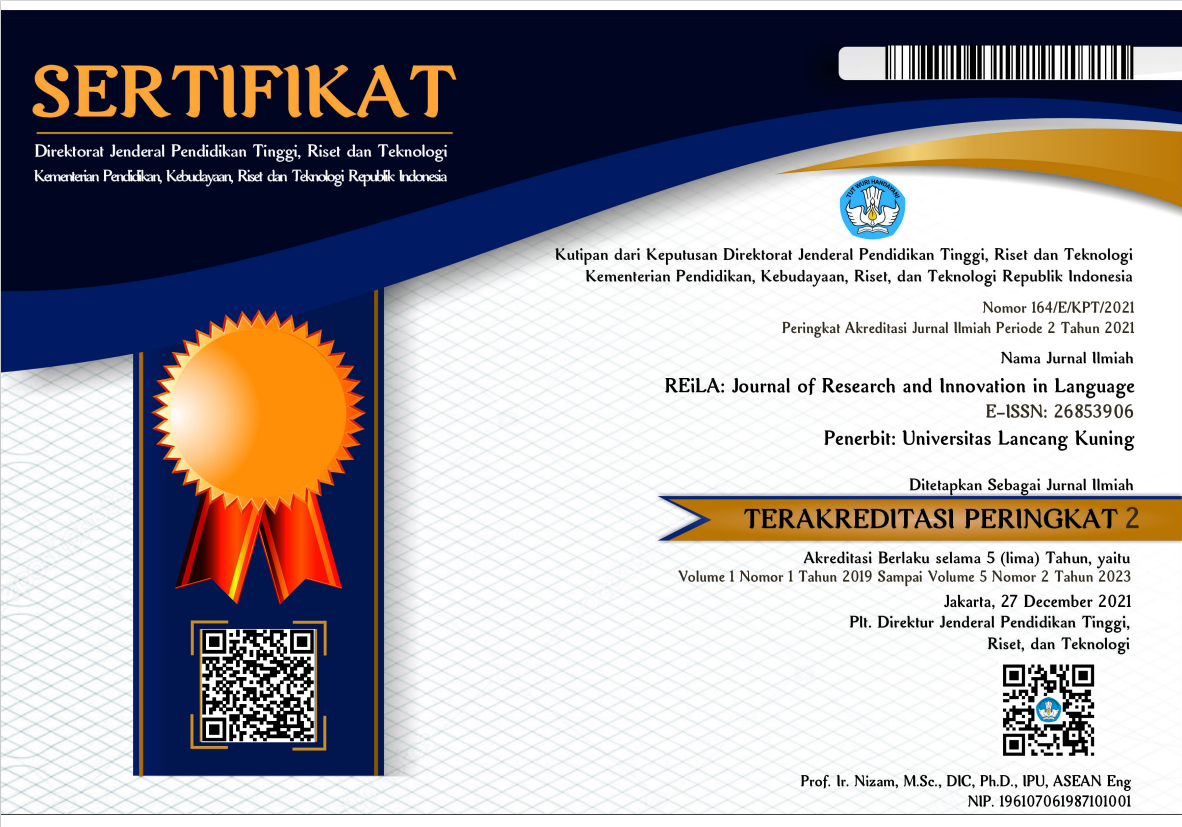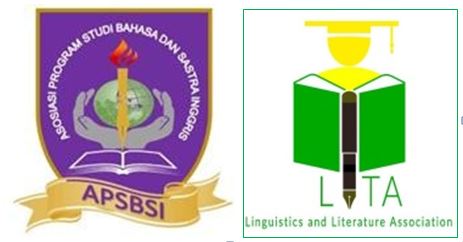The Culture Gap: An Analysis of Source, Target, and Global Culture Representation in Indonesian English Teaching Textbooks
Abstract
Most Indonesian educators are insufficient to address the importance of educating students about other cultures. This problem emerges as a result of foreign language teachers' lack of understanding of how to incorporate culture into language acquisition, particularly in English. This research aims to investigate culture's representation and examine the culture introduced in Indonesian textbooks for senior high school students who learn English as a foreign language. Employing a qualitative descriptive approach with an intercultural perspective, the study systematically analyzes the cultural content and themes present in three Electronic English teaching textbooks: Bahasa Inggris X, Bahasa Inggris IX, and Bahasa Inggris XI revised edition (2017) by Kemdikbud RI. The analysis of the textbooks' contents is conducted using the framework developed by Cortazzi and Jin (1999), specifically focusing on Source Culture, Target Culture, and International Culture. These textbooks were selected as they are widely used in Indonesian senior high schools and are published by the Indonesian Ministry of Education and Culture. The findings of the study reveal that the dominance of source culture content is significant, while the representation of target culture and international culture is considerably low. Furthermore, among the 19 cultural motifs categorized as Big Culture and Little Culture, the prevalence of Little Culture themes is most notable. The findings of this research shed light on the existing disparity and call for a more comprehensive approach to cultural education in English language learning. By acknowledging the imbalance and addressing the representation of different cultures, educators can better equip students with intercultural competence and foster a deeper understanding of diverse cultural perspectives.
Downloads
References
Aldawood, A. A., & Almeshari, F. (2019). Effects of Learning Culture on English-Language Learning for Saudi EFL Students. Arab World English Journal, 10(3), 330-343. https://doi.org/10.24093/awej/vol10no3.23
Alsaif, O. (2016). A variety of cultures represented in English language textbooks: A critical study at Saudi university. Sociology Study, 6(4), 226-244. https://doi.org/10.17265/2159-5526/2016.04.003 .
Alshenqeeti, H. (2019). Representation of culture in EFL textbooks and learners’ preference. Pedagogy Journal of English Language Teaching. 7(2), 127-135. https://doi.org/10.32332/pedagogy.v7i2.1647
Assemi, A., Saleh, S., Asayeshh, M. E., & Janfaza, E. (2012). Culture within language. International Conference on Language, Medias and Culture, IPEDR, 33, 78–82. ACSIT Press, Singapore
Awayed-Bishara, M. (2015). Analyzing the cultural content of materials used for teaching English to high school speakers of Arabic in Israel. Discourse & Society, 26(5), 517-542. https://doi.org/10.1177/0957926515581154
Baker, W. (2015). Research into practice: Cultural and intercultural awareness. Language Teaching, 48(1), 130-141. https://doi.org/10.1017/S0261444814000287
Block, D. (2013). The structure and agency dilemma in identity and intercultural communication research. Language & Intercultural Communication, 13(2), 126–147
Byram, M. (2010). Linguistic and cultural education for" Bildung" and Citizenship. The Modern Language Journal, 94(2), 317-321. https://doi.org/10.1111/j.1540-4781.2010.01024.x
Byram, M., & Golubeva, I. (2020). Conceptualizing intercultural (communicative) competence and intercultural citizenship. In The Routledge handbook of language and intercultural communication (pp. 70-85). Routledge.
Byrnes, H. (2010). Revisiting the role of culture in the foreign language curriculum. The Modern Language Journal, 94(2), 315–317. https://doi.org/10.1111/j.1540-4781.2010.01023.x
Chen, B. B. (2004). A survey on cultural learning and its variables analysis. Journal of Xi’an International Studies University, 12(3), 21-24.
Cortazzi, M., & Jin, L. (1999). Cultural mirrors: Materials and methods in the EFL classroom. Cambridge University Press.
Doró, K. (2013). On the move: Target vs. source culture representation in two EFL course books. CORE. https://api.core.ac.uk/oai/oai:publicatio.bibl.u-szeged.hu:10988
Egmen, C. (2016). The impact of culture on language teaching in EFL classes. The analysis of the new headway advanced text book through the cultural context. Çukurova Üniversitesi. https://acikbilim.yok.gov.tr/handle/20.500.12812/128106
Faris, R., & Felmlee, D. (2014). Casualties of social combat: School networks of peer victimization and their consequences. American Sociological Review, 79(2), 228-257.
Frank, J. (2013). Raising cultural awareness in the English language classroom. In English frankteaching forum, 51(4), p. 2. US Department of State. Bureau of Educational and Cultural Affairs, Office of English Language Programs.
Gómez Rodríguez, L. F. (2015). The cultural content in EFL textbooks and what teachers need to do about it. Profile Issues in TeachersProfessional Development, 17(2), 167-187. https://doi.org/10.15446/profile.v17n2.44272
Gorter, D., & Cenoz, J. (2011). A multilingual approach: Conclusions and future perspectives: Afterword. The Modern Language Journal, 95(3), 442-445. https://doi.org/10.1111/j.1540-4781.2011.01203.x
Gunantar, D. A. (2016). The impact of English as an international language on English language teaching in Indonesia. Language Circle: Journal of Language and Literature, 10(2), 141-151.
Hamiloğlu, K., & Mendi, B. (2010). A content analysis related to the cross-cultural/intercultural elements used in EFL coursebooks. Sino-US English Teaching, 7(1), 16-24.
Ilie, O. A. (2019, June). The intercultural competence. Developing effective intercultural communication skills. In International conference Knowledge-based organization (Vol. 25, No. 2, pp. 264-268). https://doi.org/10.2478/kbo-2019-0092
Jenks, C., Bhatia, A., & Lou, J. (2013). The discourse of culture and identity in national and transnational contexts. Language & Intercultural Communication, 13(2), 121–125.
Jiang, B. (2010). The role of college English textbooks in the teaching of culture in China (Doctoral dissertation, University of York).
Kramsch, C. (2014). Teaching foreign languages in an era of globalization: Introduction. Modern Language Journal 98(1): 296–311.
Lappalainen, T. (2011). Presentation of the American culture in EFL textbooks: An analysis of the cultural content of Finnish EFL textbooks for secondary and upper secondary education [Master’s Thesis, University of Jyväskylä] https://jyx.jyu.fi/bitstream/handle/123456789/26866/1/URN:NBN:fi:jyu-2011050310724.pdf
Lee, K.-Y. (2009). Treating culture: What 11 high school EFL conversation textbooks in South Korea do. English Teaching: Practice and Critique, 8(1), 76–96.
Liddicoat, A. J., & Scarino, A. (2013). Intercultural Language Teaching and Learning. Wiley-Blackwell.
Liu, S. M., (2012). Cultural Content in EFL Textbooks and Students’ Preferences: A Case Study of Non-English Major Students in China. [Thesis, Prince of Songkhla University]. CORE. https://core.ac.uk/download/pdf/32429155.pdf
Liu, S., & Laohawiriyanon, C. (2012a). Cultural content in EFL listening and speaking textbooks for Chinese university students. International Journal of English Language Education, 1(1), 82-93. https://doi.org/10.5296/ijele.v1i1.2850
Matsuda, A. (2002). Representation of users and uses of English in beginning Japanese EFL textbooks. JALT journal, 24(2), 182-200. https://doi.org/10.37546/JALTJJ24.2-5
Mayangsari, L., Nurkamto, J., & Supriyadi, S. (2018). Cultural content: An analysis of EFL textbook in Indonesia. International Journal of Scientific and Research Publications (IJSRP), 8(11), 192-199.
McKay, S. (2003). Teaching English as an international language: The Chilean context. ELT Journal, 57(2), 139-148. https://doi.org/10.1093/elt/57.2.139
McKay, S. L. (2012). Teaching materials for English as an international language. Principles and practices of teaching English as an international language, 3(9), 70-83. https://doi.org/10.21832/9781847697042-007
Mohammed, A. (2020). The impact of culture on English language learning. International Journal on Studies in English Language and Literature (IJSELL), 8(1), 21-27. https://doi.org/10.20431/2347-3134.0801003
Offorma, G. C. (2016). Integrating components of culture in curriculum planning. International Journal of Curriculum and Instruction, 8(1), 1-8.
Opoku-Amankwa, K., Brew-Hammond, A., & Kofigah, F. E. (2011). What is in a textbook? Investigating the language and literacy learning principles of the ‘Gateway to English’textbook series. Pedagogy, Culture & Society, 19(2), 291-310.
Putra, T. K., Rochsantiningsih, D., & Supriyadi, S. (2020). Cultural representation and intercultural interaction in textbooks of English as an international language. Journal on English as a foreign language, 10(1), 163-184.
Qodriani, L. U., & Kardiansyah, M. Y. (2018). Exploring culture in Indonesia English textbook for secondary education. Jurnal Pendidikan Indonesia, 7(1), 51-58.
Qu, Y., & Telzer, E. H. (2017). Cultural differences and similarities in beliefs, practices, and neural mechanisms of emotion regulation. Cultural Diversity and Ethnic Minority Psychology, 23(1), 36. https://doi.org/10.1037/cdp0000112
Scarino, A. (2010). Assessing intercultural capability in learning languages: A renewed understanding of language, culture, learning, and the nature of assessment. The Modern Language Journal, 94(2), 324-329. https://doi.org/10.1111/j.1540-4781.2010.01026.x
Setyono, B., & Widodo, H. P. (2019). The representation of multicultural values in the Indonesian Ministry of Education and Culture-Endorsed EFL textbook: a critical discourse analysis. Intercultural Education, 30(4), 383-397.
Sihombing, T. H., & Nguyen, M. X. N. C. (2022). Cultural content of an English textbook in Indonesia: text analysis and teachers’ attitudes. Asian Englishes, 1-23.
Spencer-Oatey, H., & Franklin, P. (2012). What is culture? A compilation of quotations. GlobalPAD Core Concepts, 1, 22.
Syrbe, M., & Rose, H. (2018). An evaluation of the global orientation of English textbooks in Germany. Innovation in language learning and teaching, 12(2), 152-163. https://doi.org/10.1080/17501229.2015.1120736
Wu, J. (2016). A content analysis of the cultural content in the EFL textbooks. Canadian Social Science, 6(5), 137–144.
Xiao, J. (2010). Cultural contents of an in-use EFL textbook and English major students’ attitudes and perceptions towards culture learning at Jiangxi University of Science and Technology, China [Doctoral dissertation, Prince of Songkla University].PSU. https://kb.psu.ac.th/psukb/bitstream/2010/7836/1/326069.pdf
Xiaole, G. U., Meng, M. E. N. G., & Manli, L. I. (2012). A survey on teachers' perception and practice of ICC assessment of university English learners in China. Intercultural Communication Studies, 21(1). 205–220.
Yamanaka, N. (2006). An evaluation of English textbooks in Japan from the viewpoint of nations in the inner, outer, and expanding circles. JALT journal, 28(1), 57. https://doi.org/10.37546/JALTJJ28.1-4
Yuen, K. M. (2011). The representation of foreign cultures in English textbooks. ELT Journal, 65(4), 458-466. https://doi.org/10.1093/elt/ccq089










